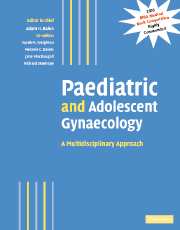Book contents
- Frontmatter
- Contents
- Contributors
- Preface
- Part I Normal development
- Part II Management of developmental abnormalities of the genital tract
- Part III Management of specific disorders
- 18 Disorders of growth and puberty
- 19 Turner's syndrome
- 20 Androgen insensitivity syndromes
- 21 Rokitansky syndrome and other Müllerian anomalies
- 22 The XY female
- 23 The gynaecology of the major genitourinary anomalies
- 24 Congenital adrenal hyperplasia
- 25 Long-term sequelae of genital surgery
- 26 Amenorrhoea
- 27 The polycystic ovary syndrome and adolescent women
- 28 Menstrual disorders in adolescent girls
- 29 Pelvic pain, ovarian cysts and endometriosis in adolescent girls
- 30 Premature ovarian failure and ovarian ageing
- 31 Gynaecological cancers in childhood
- 32 Late reproductive sequelae of treatment for childhood cancer
- 33 Preservation of fertility before cancer therapy
- 34 The management of infertility with surrogacy and egg donation
- 35 Dermatological conditions of the female genitalia
- 36 Vaginal discharge
- 37 Psychological gender development in individuals born with ambiguous genitalia
- 38 Eating disorders in adolescence
- 39 Nutritional amenorrhoea: long-term sequelae
- 40 How to set up a service: how to teach and train
- Index
- Plate section
- References
38 - Eating disorders in adolescence
from Part III - Management of specific disorders
Published online by Cambridge University Press: 04 May 2010
- Frontmatter
- Contents
- Contributors
- Preface
- Part I Normal development
- Part II Management of developmental abnormalities of the genital tract
- Part III Management of specific disorders
- 18 Disorders of growth and puberty
- 19 Turner's syndrome
- 20 Androgen insensitivity syndromes
- 21 Rokitansky syndrome and other Müllerian anomalies
- 22 The XY female
- 23 The gynaecology of the major genitourinary anomalies
- 24 Congenital adrenal hyperplasia
- 25 Long-term sequelae of genital surgery
- 26 Amenorrhoea
- 27 The polycystic ovary syndrome and adolescent women
- 28 Menstrual disorders in adolescent girls
- 29 Pelvic pain, ovarian cysts and endometriosis in adolescent girls
- 30 Premature ovarian failure and ovarian ageing
- 31 Gynaecological cancers in childhood
- 32 Late reproductive sequelae of treatment for childhood cancer
- 33 Preservation of fertility before cancer therapy
- 34 The management of infertility with surrogacy and egg donation
- 35 Dermatological conditions of the female genitalia
- 36 Vaginal discharge
- 37 Psychological gender development in individuals born with ambiguous genitalia
- 38 Eating disorders in adolescence
- 39 Nutritional amenorrhoea: long-term sequelae
- 40 How to set up a service: how to teach and train
- Index
- Plate section
- References
Summary
Introduction
The main eating disorders so far described are anorexia nervosa, bulimia nervosa and binge-eating disorder. This chapter will concentrate, for reasons of space, on the first two.
Historically, the eating disorders have all suffered from being seen as a “backwater” of psychiatry and medicine, as seen by the late acceptance of all of them as illnesses, the still prevalent view of anorexia and bulimia nervosa as “slimmers' diseases” and the fact that binge-eating disorder has only established itself as a diagnosable disorder in the fourth edition of The Diagnostic Standard Manual (DSM-IV; American Psychiatric Association, 1994). This has occurred despite the description of anorexia nervosa as an illness since the 1860s (Gull, 1874; Lasegue, 1873) and bulimia nervosa since 1979 (Russell, 1979).
Two other profound discrepancies exist between the emphasis that these illnesses have been afforded and the reality regarding them. Anorexia has the highest morbidity and mortality of any psychiatric illness (Nielsen et al., 1998) and presents a similar burden of care to that of severe psychoses (Treasure and Serpell, 2001).
Both anorexia and bulimia present primarily, but not exclusively, as disorders of adolescence for a number of postulated reasons (see below); however, as the illnesses often run a chronic course, professionals in all disciplines, beyond childhood, will see “graduate” cases as well as those of primary onset. Consequently, paediatricians and psychiatrists managing adolescents (traditionally puberty—adult; usually considered as 14–18 years) will see prepubertalonset child “graduates” and pre- and postpubertal adolescent-onset patients.
- Type
- Chapter
- Information
- Paediatric and Adolescent GynaecologyA Multidisciplinary Approach, pp. 509 - 521Publisher: Cambridge University PressPrint publication year: 2004



